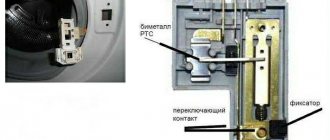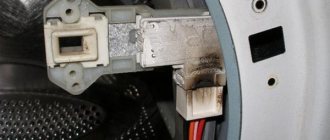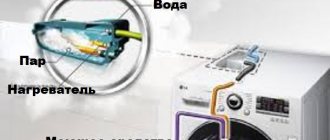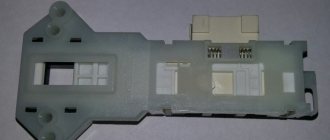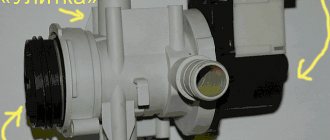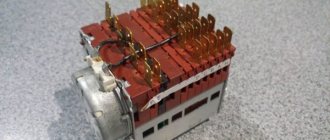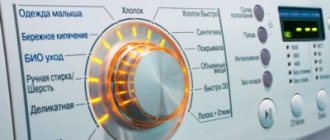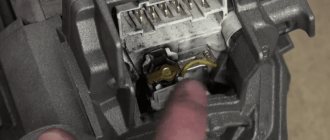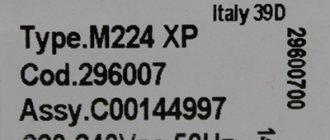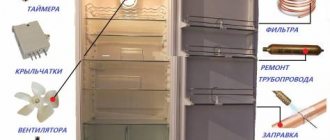Date: 05/07/2015
We think that we will not be lying if we say that almost every person on the planet knows what a washing machine is, of course, if this person lives in society and not in the deep taiga. And in the taiga, they probably already know about washing machines. We all use them, but few of us have thought about the operating principle of an automatic washing machine. Today we want to tell you how an automatic washing machine works, what washing processes the laundry goes through and we think that you will like it.
We will tell you in the order in which this process occurs, i.e. for you it will be as if you are taking part in the process of washing your laundry and watching it from the outside.
Start of washing
It all starts with the fact that we load laundry and powder into the washing machine, open the water supply tap, and then select a washing program. As soon as you have selected the washing program and pressed the start button. The software module received a signal from you that it needs to start washing. The washing process is already built into it and will be performed according to a specific pattern that you have chosen (washing program).
First of all, the laundry loading hatch is blocked to prevent its accidental opening during the washing process. Next, a signal is sent to the water supply valve, which opens. At this time, water begins to flow into the powder receiver and wash the powder from the tray into the tank. As a result, the tank fills with water.
The washing machine is equipped with a water level sensor, which determines how much water is in the tank and as soon as the sensor is triggered, the water supply valve closes. That's it, now it turns out that in the tank there is water with powder, and in the drum there is dirty laundry in this water. The machine is ready for washing.
Water supply
Water is supplied to the washing machine through special hoses connected to the water supply in the apartment. How long it takes to fill the tank depends on the equipment parameters. The system can be set to a certain level for washing.
The design also includes pressure monitors, which are small sealed containers with membranes at the inlet. As soon as the desired water level is reached, the pressure inside the container increases. The contact system allows you to close the valve, thereby stopping the flow.
Some machines use pressure sensors in the form of special electronic controllers created using semiconductor technology. In this case, increasing water level with increasing pressure changes the electrical conductive characteristics of the device. The received signal is sent to the control board.
The regulators protect the system from flooding, prevent the heating element from running dry, and also act as foam detectors.
How the washing machine drum works
To make it clearer, we’ll tell you how the tank and drum work. A tank is a kind of reservoir, like a barrel, inside of which there is a drum. Water is filled into the tank, and it enters the drum through small holes with which it is completely permeated. The tank always remains stationary and the drum is driven by a motor through a belt. To remove the drum of a washing machine, you always have to disassemble the tank, and nothing else.
If this LG is with direct drive, then this whole thing can be done without a belt.
Features of units with vertical loading
Top-loading washing machines have most of the parts the same as front-loading models: tank, drum, motor, shock absorbers, etc.
Top-loading washing machines have some design features
The body of such units is equipped with a hinged lid through which laundry is loaded. The drum is mounted on two bearing units and has flaps (many units are equipped with a self-positioning sensor, which ensures that the flaps stop exactly opposite the top cover). The control panel is usually located on the far side at the top of the case.
Many units of this type do not have a rubber sealing collar, since the design features of the tank and drum (with a hole at the top) practically eliminate water leakage through the lid. For the same reason, forgotten laundry can usually be added to such a washing machine throughout the entire wash cycle.
We hope that our article will help you learn more about a home assistant.
Washing machine washing process
We have laundry in the tank, water and powder too. And the programmer gives a signal to the engine to start rotating. The motor begins to rotate the washing machine drum. What is happening inside at this moment? The drum begins not only to splash water, but also to turn the laundry over with the help of special metal protrusions inside the machine, you can see them below in the photo.
There is a mechanical effect on the laundry, similar to what we do when we wash clothes by hand. Only compared to hand washing, everything happens much faster and more efficiently. Since washing in many programs occurs with warm and hot water, the electric heater is turned on, which heats the water until it receives a signal from the temperature sensor that the water has heated up to the required temperature.
A heating element is a tubular electric heater located at the bottom of the tank and is intended only to heat water. The washing machine makes a certain number of revolutions in a certain direction, at a given speed, depending on the program you set.
General information
The first machine for washing clothes was described in 1752 under the name "Yorkshire Maid". It consisted of a wooden tank that could be closed with a lid and filled with laundry and hot soapy water. In the center of the lid was a wooden block with a handle at the top for turning, and at the bottom there was a wooden disk with recessed wooden pins that moved the laundry in the soapy water, turning back and forth. The size of this machine and its manual operation made it suitable for small households.
Draining water and rinsing clothes
After the washing program pattern is completed, the programmer sends a signal to the drain pump so that the latter begins to pump out water and drain it into the sewer through the drain hose. Dirty water is drained. The pump operates until a signal is received from the water level sensor indicating that there is no more water in the tank.
The rinse cycle then starts. Similar to the start of washing, water is supplied to the tank, only this time without powder; instead, the machine washes out the container with rinse aid. Water enters the tank again, and the machine begins to rotate again according to the given program. The process can be repeated, the machine can fill and drain water more than once, depending on the rinsing mode. After the machine has finished rinsing, the water is drained into the drain again and the spinning process begins.
Frame
All elements of the washing machine, regardless of the brand - Indesit, LG, Samsung, Ariston, Electrolux, Bosch or another, are located inside its metal body. The case consists of a base, a front panel with a hatch, a top cover, side walls, and a back wall.
At the top of the front wall of the case there is a control panel, and in the left corner there is a container for loading detergent (dispenser). Typically, such a container has 3 cells (two for powder and one for liquid), but there may be more or less of them depending on the model (from 1 to 5). The powder loaded into the dispenser through one or more pipes enters the tank under the influence of a stream of water.
In the center of the front wall there is a hatch for the washing machine. It contains parts such as a rubber cuff for the hatch and a device responsible for blocking the hatch during washing. Inside, the cuff is attached to the tank using a clamp. Thanks to the locking device, the door cannot be opened during the washing process. Most often, such a device has a thermocouple, so after finishing the wash the door remains closed for some time.
Spinning clothes
As soon as the washing and rinsing program is completed, the laundry spin program is turned on (provided that it is not turned off). The operating principle of spinning clothes is based on the laws of physics: the drum spins up to high speeds (usually 800-1600 rpm on different washing machines). The centrifugal force begins to push the laundry outward, pressing it against the drum, and at the same time all the water in the laundry is pushed out. If the laundry itself has nowhere to go beyond the aisles of the drum, then the water through the holes in the drum goes beyond its aisles into the tank, where it flows to the bottom of the tank and is pumped out by a pump into the sewer. Accordingly, the higher the spin speed, the more water will come out of the laundry and the drier the laundry will be.
As you understand, the laundry unwinding in the drum creates an imbalance, forming the eccentric principle. To prevent the machine from vibrating too much, heavy counterweights are installed on the tank to compensate for this load.
The spin speed of laundry in different programs may be different; for delicate fabrics, the spin will be at lower speeds or completely turned off; for fabrics that do not require special care, the spin will be maximum. You set all these parameters by selecting the washing program at the beginning.
How does a machine wash automatically?
The principle of washing remains the same - it is a mechanical interaction with the laundry. Only, unlike activator-type machines, this effect is carried out by the perforated walls of the drum.
The implementation of the selected program is ensured by the degree of water heating, its quantity, washing time and detergent for automatic washing machines (no matter liquid or powder). And for a more intense or, conversely, delicate mechanical action on the laundry, a special algorithm of drum movements is responsible. It can rotate in opposite directions with the same or different frequencies (depending on the program). Or not even make a full rotation, but rather rock the laundry for the most delicate washing.
From different manufacturers, the walls of the drum can be standard (smooth with a system of holes), or they can be of a special shape and are designed to provide a better washing result (for example, a honeycomb drum). Of course, each manufacturer claims that its drum is the best, and its movement algorithm is the most effective.
End of wash
After all washing, rinsing and spinning programs have been completed, the machine ends the program. But before that, he makes several rotations with the drum so that the laundry is evenly distributed throughout the drum. The car stops, but you cannot open the door. The lock has a lock, which is released 1-2 minutes after the end of the program. After this time, the hatch lock will unlock and we can take things out of the machine and go hang them up.
If the door of your washing machine does not open after finishing washing, then read how to unlock the washing machine door at this link.
We have described the operating principle of an automatic washing machine quite simply, from the point of view of the common man, without going into technical details. After reading this article, you will understand the general principles and know how a washing machine works. If you want to delve into this topic in more detail, then read about the structure of a washing machine on our website.
Performing parts
As the name implies, this group of parts works by receiving signals from other sensors and does not generate any impulses on its own, and in some cases is a purely mechanical component.
The list of performing parts includes:
- Electrical engine.
- TEN-heater.
- Hatch locking device.
- Drain pump.
- Tank with drum.
- Shock absorption system (springs, counterweights).
- Drum pulley.
Let's look at each detail in more detail.
The electronic unit gives a command to the parts, after which they begin to work.
Electric motor
The washing machine engine generates revolutions at all stages of washing for the drum. The torque from it is transmitted to the drum through a drive belt or direct connection.
The engine speed is regulated with the participation of a tachogenerator; the control unit is responsible for supplying a particular voltage level to the motor. This ensures that the drum speed corresponds to the selected washing mode.
Their design is reliable, so such motors rarely break down.
As a rule, the electric motor is a fairly reliable component of the washing machine; it rarely fails. The most common causes of failure are water, insects, and foreign objects getting inside electrical components. This leads to a short circuit in the winding; in the event of such a breakdown, the engine must be repaired, and if such work is impossible, it must be replaced.
The engine is located under the drum; the most common method is a belt connection to the drum.
Electric heater (TEH)
The heating element in modern washing machines is often a consumable part. All due to the low quality and high aggressiveness of water in modern pipelines. Scale is the main reason for heater failure. Therefore, many manufacturers recommend periodic maintenance of their machines with special cleaning agents.
The electronic unit sends a specified signal to the heating element, after which heating is performed.
A heating element is a tubular device, the metal cavities of which are filled with a special composition to improve heat transfer.
It is located at the bottom of the drum, access to it is quite easy and, if necessary, anyone can replace the heating element.
Note! When carrying out such work, it is necessary to disconnect the washing machine from the power supply and drain the water from the tank.
Hatch locking device
In essence, this system is a simple solenoid lock, which is in the “open” mode when not working.
When you turn on any washing program, the hatch for loading things is blocked to prevent it from opening while the machine is operating.
This is an electronic door lock. You manually close only the mechanical door lock. When the program starts, a click is heard, which indicates that the hatch is locked.
After completing the selected program, the lock returns to its non-working mode, allowing access to things.
Drain pump
This mechanism is in second place after the heating element in terms of failure rate. Especially if before washing it is not practiced to check the pockets of things and remove excess change from them. Once in the drain system, such unwanted parts block the unhindered drainage of water, which can lead to pump failure.
Almost every machine has a system for cleaning drain pipes, which allows, first of all, to remove unwanted elements from them. After the drum with dirty clothes has gone through several cycles, the water is usually replaced. This is what the drain pump is used for.
The pump allows you to pump water out of the tank after washing and rinsing. There are synchronous and asynchronous pumps.
Tank design
The tank is the most bulky element of the washing machine. It is a plastic case containing a metal drum, a heating element and a thermostat.
The tank must have pipes for connecting the water supply system and draining it.
Recently, many manufacturers have been using non-separable type tanks, in which, if the rotation bearing fails, it is necessary to completely replace this element, or to purchase new equipment.
The tank can be made of steel or plastic. The latest development is a polyplex tank.
Shock absorbers
When operating at high speeds, the washing machine tank is inevitably exposed to large forces that rock it. Shock absorbers are designed to smooth out such vibrations.
During the operation of the washing machine, they take on all the loads, so they also break down with frequent overloads. The main signs of faulty shock absorbers include excessive vibrations of the washing machine body. This may eventually cause the main drum bearing to break.
Dampers or shock absorbers are parts that dampen vibrations during the operation of the SMA.
One of the symptoms of faulty dampers is that the electric motor drive belt periodically falls off.
Note! Replacing faulty shock absorbers yourself is not recommended, since it requires dismantling the drum mechanism.
Springs
Springs provide an additional damping effect when the washing machine operates at high speeds. Unlike shock absorbers, which dampen longitudinal vibrations, springs are responsible for the absence of horizontal vibrations.
It is thanks to them that the tank remains in a relatively motionless state on its axis, as far as possible. Being a simple mechanical element, springs can stretch due to frequent overloads, in which case they should be replaced. This can be done without removing the drum. It is enough to open the top cover of the case and carry out the necessary work.
Springs hold the tank on top and perform the same function as shock absorbers.
Pulley
The drum pulley is involved in the process of transmitting torque from the electric motor. Most often, such work is performed by a drive belt; in some cases, you can find models with a direct connection between the pulley and the drum.
This part is quite reliable and can only fail if the belt is skewed, but under normal operating conditions of the washing machine this practically never happens.
If the washing machine has a belt-driven motor, then a pulley is attached to the tub.
Counterweights
The heaviest and most monumental part of the entire “washing machine”. It can be produced in two types - top plate and side panels. In both cases, it is a dense and heavy element that provides additional vibration damping and prevents the drum from transmitting strong vibration to the body.
To ensure the best stability, when installing the machine in a permanent place, you need to ensure that it is level.
Heavy blocks are made of concrete or plastic. They are bolted to the outside of the tank to restore balance.
Drum
The drum structure of an Indesit washing machine is a metal cylinder with a large number of holes through which water flows and drains to the clothes. The tank and drum are fastened together with a rubber cuff. This design allows you to dampen vibrations that occur when the drum rotates, and also ensures the tightness of the tank.
A shaft is attached to the back of the drum, through which it rotates via a belt drive. A bearing is installed between the shaft and the tank body, which performs 2 functions at once:
- Ensuring drum rotation.
- Additional sealing of the tank.
Located inside the tank, made of stainless steel.
If this bearing fails, a complete replacement of the tank may be required. This happens in cases where the system is not dismountable.
Important! The main reason for drum bearing failure is periodic excessive overload during washing. Therefore, you must always adhere to the requirements of each model for the maximum weight of laundry available for loading.
Drain system
The main elements of the drainage system of an automatic machine are a drain pump and a plastic corrugated drain hose 1-4 meters long. One part of the hose is attached to the pump using a clamp, and the second is discharged into the sewer system.
Draining should normally be performed several times during washing. The pump consists of a motor, an impeller and a “snail” to which the hoses are connected. The pump is most often synchronous. The operation of the pump is controlled by an electronic module.
Related article: Reviews about interior doors made of MDF
Since the most common malfunction of the drain system is the failure of the pump due to its blockage, the design of the machine provides for easy access to the pump for regular cleaning. It is recommended to check and clean the pump filter at least once every 6 months.

